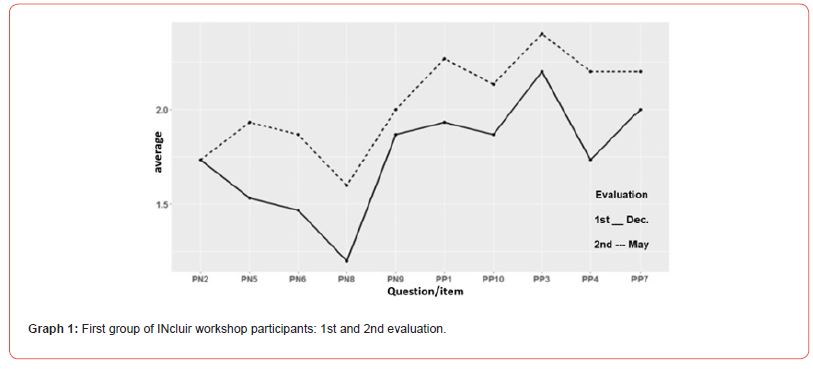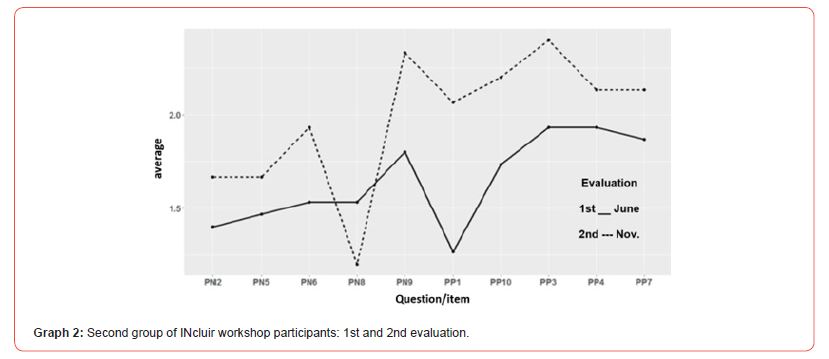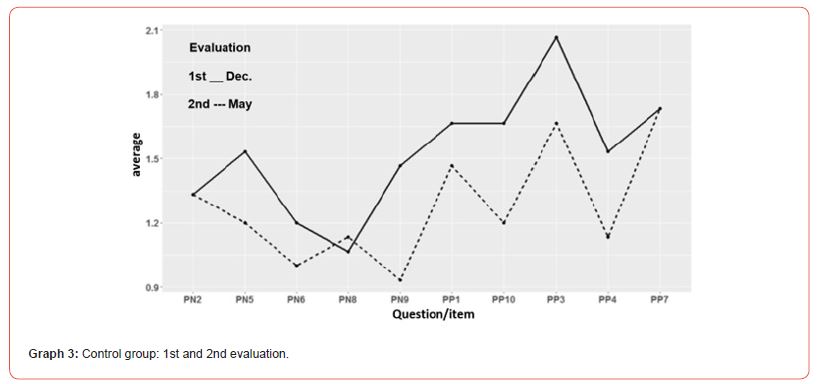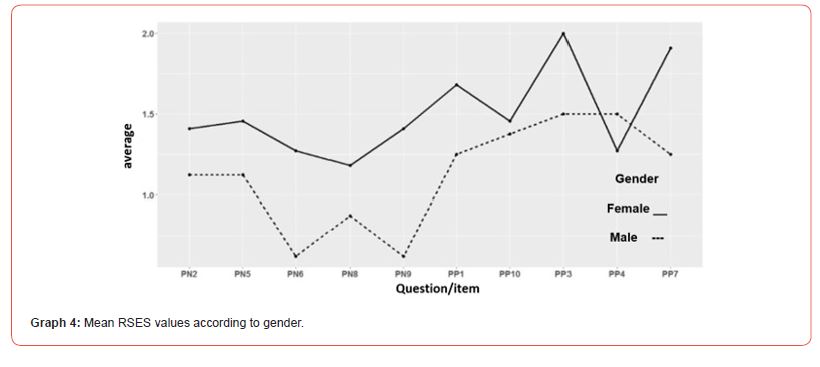 Research Article
Research Article
The Contribution of the Artistic Workshops Measured by the Rosenberg Self-Esteem Scale
Ricardo São João*1, Carla Ferreira2 and Teresa Coelho3
1Department of Computer Science and Quantitative Methods -School of Management and Technology -Polytechnic Institute of Santarém; Santarém - Portugal
1Member of CEAUL - Centro de Estatística e Aplicações Universidade de Lisboa, Lisbon - Portugal
1Collaborator at the Centre for Global Studies of the Universidade Aberta (CEG-UAb), Portugal
1Collaborator at the Lisbon Centre for Research, Innovation and Development in Nursing (CIDNUR), Lisbon - Portugal
2Psychiatry Department, Santarém District Hospital, Santarém – Portugal
3School of Health - Polytechnic Institute of Santarém; Santarém - Portugal
3Doctoral Researcher at CIEQV - Life Quality Research Center
Ricardo São João Department of Computer Science and Quantitative Methods -School of Management and Technology -Polytechnic Institute of Santarém; Santarém – Portugal. Member of CEAUL - Centro de Estatística e Aplicações Universidade de Lisboa, Lisbon – Portugal. Collaborator at the Centre for Global Studies of the Universidade Aberta (CEG-UAb), Portugal. Collaborator at the Lisbon Centre for Research, Innovation and Development in Nursing (CIDNUR), Lisbon – Portugal.
Received Date: October 27, 2023; Published Date: December 05, 2023
Abstract
Mental health is now considered indispensable for well-being and general health. Self-esteem, in turn, is an important indicator of mental health. Knowing the self-esteem of people with Mental Illness thus becomes an important part of the process of help and recovery, promoting the implementation of appropriate therapeutic measures. This study aims to determine the impact of the INcluir workshops on participants’ self-esteem, an experimental study composed of adult participants of both genders. Two groups were created: the control group composed of participants who did not attend the artistic workshops and the experimental group who attended the workshops. The Rosenberg Self-Esteem Scale (RSES) was used to measure the levels of self-esteem.
Considering the results obtained, the artistic workshops produced improvements in the participants’ self-esteem.
Keywords:Art workshops; Self-esteem; Rosenberg scale; Mental health
Introduction
The annual prevalence resulting from the National Epidemiological Study of Mental Health [1] shows that psychiatric disorders affect more than a fifth of the Portuguese population. This prevalence is the second highest in Europe. Knowing that there is a relationship between self-esteem and mental illness (MI), it is necessary to work on self-esteem [2]. Understanding the self-esteem of people with MI is relevant to the helping process and to this end the Rosenberg Self-Esteem Scale (RSES) was used. The RSES was developed by Rosenberg and presented as a onedimensional measure of self-esteem.
Self-esteem can be defined as a person’s individual assessment of themselves, which can be intrinsically positive or negative. Rosenberg [3] defines self-esteem as a positive or negative attitude towards the self. According to Townsend [4], self-esteem refers to the degree of consideration or respect that individuals have for themselves and is an important measure of self-worth in terms of abilities and judgements.
There is a consensus on the need for multidisciplinary interventions in the rehabilitation of people with MI, which should include psychosocial interventions to increase the effectiveness of rehabilitation [5-7] and should be present from the initial phase of the disease and accompany its evolution with the appropriate adaptations to the moment [6].
The “INcluir- OficINas para todos e para cada um” project is based on the creation of “artistic workshops”, which aim to enhance the personal, relational, and artistic skills of the participants and consequently increase acceptance and recognition of the value of people with MI by the community, thus minimizing stigma and social exclusion. The activities developed in the therapeutic workshops enhance the materialization of thoughts and emotions, becoming an alternative way of communication [8], and can also contribute to changing the routines of people with MI [9], removing them from a passive position to an active one [10] and giving them the opportunity to see that they too have the capacity to carry out tasks successfully.
The main aim of this research is to determine the impact of the INcluir workshops on the participants’ self-esteem. As study hypotheses we defined: participation in artistic workshops has a significant impact on participants’ self-esteem.
Methodology
This is a quasi-experimental study whose population is made up of all the people who attended the INcluir workshops, art workshops where painting, drawing and sculpture skills were developed. Participants with severe MI, aged 18 and over, of both sexes, attended the INcluir workshops for one semester, with a weekly frequency of two sessions of 120 minutes each. 15 people were involved per group and per semester. The study refers to one year of the project’s development, with 30 people taking part. The first group ran from December 2018 to May 2019 and the second group from June to November 2019; the same artistic skills were developed for each group. The inclusion criteria for taking part in the workshops were being a psychiatrist and having a serious MI; the exclusion criteria were having a disability. In each group, the Rosenberg scale was applied twice to all the participants: firstly, at the beginning of the artistic workshops and secondly at the end of the workshops. There was also a control group of 15 people with severe MI who didn’t take part in the art workshops but were undergoing outpatient treatment in psychiatry, to whom the Rosenberg scale was applied at the same time.
The study was analyzed in two ways: descriptive and inferential. The descriptive analysis sought to characterize the participants. The measure of location is the mean, accompanied by the respective standard deviation symbolized by (± sd). In addition, the analysis focused on the results obtained according to the Rosenberg scale, which were stratified according to the variables gender, group (artistic workshops INclude vs. control), first and second evaluation. The inferential component used appropriate multivariate statistics in order to determine (or not) the statistical significance of the contribution of the artistic workshops. The following statistical tests were used: the non-parametric chi-square test to check for an association/relationship between the level of self-esteem and the participant’s group; the Shapiro-Wilk test to test the normality of the distributions; the parametric paired t-test to test the equality of the mean values of the sum of the RSES scores at the two assessment moments and the McNemar test to test whether the proportion of expected improvements in the participants of the INclude Workshops is identical to the control group. Before the Rosenberg Self-Esteem Scale (RSES) was applied, the participants were asked for their cooperation orally and in writing, with prior information about the study and its purpose, a guarantee of confidentiality and anonymity and the possibility of withdrawing at any time during the project, as well as the absence of correct or incorrect answers. The project protocol was submitted for evaluation and authorized by the hospital’s Ethics Committee.
Data Collection Instrument
The Portuguese version of the RSES [3], translated and adapted by Santos and Maia [11], was used to assess self-esteem. It is a fourpoint Likert scale with discrete values between zero and three. This scale contains ten items in the form of statements, half of which are positive statements, and the rest are negative statements. Total scores can vary between 0 and 30, with higher scores showing higher levels of overall self-esteem [11]. When interpreting the results of the scale, the commonly used norm is: i) Scores below 15 indicate very low self-esteem; ii) Scores between 15 and 25 indicate healthy self-esteem, within the parameters of what is considered “balanced”; iii) A score above 25 reveals a robust person, but it can also indicate a person who has difficulty perceiving their own reality and/or is too complacent with themselves (Santos and Maia, 2003). Each positive statement receives a score from 0 (strongly disagree) to 3 (strongly agree), while negative statements are scored in the opposite direction: 3 (strongly disagree) and 0 (strongly agree). For simplicity of sake and to make it easier to identify the information, particularly in the graphs used, a nomenclature was adopted with the following meaning: i) the first two digits identify the affirmative/positive and negative statements respectively by PP and PN, ii) the remaining digits (maximum 2) identify the order of the statement in the questionnaire (for example: PP10 refers to a positive statement referring to the tenth statement). In view of the above, the items of the RSES are presented below:
PP1-Overall I am satisfied with myself;
PN2-Sometimes I think I’m not good at anything;
PP3-I feel I have some qualities;
PP4-I’m able to do things as well as most people;
PN5-I feel I don’t have much to be proud of;
PN6-Sometimes I really do feel worthless;
PP7-I feel like a person of value, at least as much as most people;
PN8-I would like to have more respect for myself;
PN9-After all, I’m inclined to feel that I’m a failure;
PP10- I adopt a positive attitude towards myself.
The data obtained was analyzed using the R programming language [12].
Results
Participants
The first group that attended the artistic workshops was made up of ten women (≅67%) and five men (≅33%) with an average age of 49.47 years (±10.58 years). The women had an average age of 54.9 years (± 7.26 years) and the men 38.6 years (± 7.16 years). The control group consisted of eleven women (≅73%) and four men (≅27%) with an average age of 43.20 years (±13.33 years). The women had an average age of 47.18 years (± 12.85 years), higher than the men’s 32.25 years (± 7.80 years). The second group that took part in the artistic workshops was made up of eight women and seven men with an average age of 47.73 years (±17.04 years). The women had a higher average age of 54.63 years (± 19.59 years) than the men, 39.86 years (± 9.70 years).
Descriptive analysis
Graph 1 shows the results in terms of the average values of the answers obtained for the first group of workshop participants for each item on the Rosenberg scale. All the aspects assessed showed higher values after taking part in the INcluir workshops. It should also be noted that the most obvious improvements between the first and second evaluations are related to performance and satisfaction with oneself [PP1-Overall I am satisfied with myself: 2.13 vs 1.87; PP4-I’m able to do things as well as most people: 2.2 vs 1.73; PN5-I feel I don’t have much to be proud of: 1.93 vs 1.53; PN6-Sometimes I actually feel useless: 1.87 vs 1.47 and PN8-I’d like to have more respect for myself:1.6 vs 1.2] (Graph 1).

Graph 2 shows the results in terms of the average values of the answers obtained for the second group of participants in the INcluir workshops for each item on the Rosenberg scale. All the aspects assessed showed higher values after taking part in the INcluir workshops, with the exception of item PN8 - I would like to have more respect for myself, which had an average decrease of 0.33 [1.53 to 1.2] (Graph 2).
Graph 3 shows the results of the application of the Rosenberg scale to the control group and shows that, in the period between the first and second evaluations, there was no overall improvement, i.e.: the results obtained in the second application show a worse perception of self-esteem, with the exception of statement PN8: I would like to have more respect for myself [1.13 vs 1.07] (Graph 3).
Graph 4 shows the overall average values of the answers obtained by applying the Rosenberg scale by gender for both groups (first and second). Overall women perform better than men. Apart from statement PP4: “I’m able to do things as well as most people” where the average results for men were higher (PP4:1.72 vs 1.62) (Graph 4).



Inferential analysis
In the inferential study, appropriate multivariate statistics were used to determine (or not) the statistical significance of the contribution of artistic workshops, taking into account the variables already recommended in the descriptive study as well as the adoption of others created for this sole purpose, which will be described in due course. In the results that are subsequently presented, where applicable, we define: i) T.S as Test Statistic; ii) df as degrees of freedom. The significance level set was alpha=5%. For the first group, which attended the workshops, the results of the two evaluations were compared, corresponding to the evaluation of the ten items on the Rosenberg scale. Three levels of self-esteem were considered in the two groups (Control vs artistic workshops INcluir): increase (higher scores in the second evaluation compared to the first); maintenance (equal scores in both evaluations); decrease (lower scores in the second evaluation compared to the first). A non-parametric Chi-Squared test was used to check whether there was an association/relationship between self-esteem status and the participant’s group. Based on the information analyzed, Table 1 was drawn up, to which this test was applied. The total of 150 responses per group corresponds to the 15 participants in each group multiplied by the ten items on the Rosenberg scale, and the frequency of the level of self-esteem was recorded by comparing the results of the 1st and 2nd assessments (Table 1).
Table 1: Level of self-esteem in the first group.

The Chi-Square test revealed a very strong relationship/ association between the group of participants and the level of selfesteem (p-value<0.001; T.S=32.52; df= 2). This result emphasizes an improvement in the level of self-esteem among the participants in the artistic workshops, as well as a lower risk of regression. Table 2 shows that the reading of the RSES evaluations is more favorable in the INcluir Workshops group, whose interpretation points to a healthy self-esteem, within the parameters of what is considered “balanced”; whereas in the control group, self-esteem is very low (Table 2).
Table 2: Reading the Results on the Rosenberg Scale.

The aim was to see if there were any statistically significant differences between the results of the first and second evaluations. Since the distribution of the difference in results between the evaluations is normally distributed (Shapiro-Wilk test: p-value=0.2438; T.S= 0.92674), the parametric t-pairs test was used and concluded that there was strong statistical evidence (p-value=0.005), which translates into better well-being “performances” at the second assessment point.
Lastly, the aim was to assess whether self-esteem had improved or declined. We chose to calculate the difference in RSES between the second and first evaluation in both groups (participation in artistic workshops - both groups and control group). Using McNemar’s non-parametric test, we concluded that the changes in the proportions were marginally significant (p-value=0.058, T.S=3.6: df=1) and that the estimated odds ratio was 4, i.e. the proportion of improvements expected in the participants of the INcluir Workshops was four times higher than in the control group. Participation in the workshops boosted self-esteem four times more, compared to the control group who had no participation in artistic workshops.
Discussion
The relationship between art and mental health is not a recent one; there are reports dating back to the 19th century where these two fields coexisted, and art was presented as a therapeutic possibility. The results mobilized here come from the development of artistic workshops in which art is used as a therapeutic possibility and resource in the context of care [13]. The study found that the participants in the art workshops, when compared to the control group, had statistically significant higher mean scores in the RSES, which is in line with Shen and Armstrong’s [14] assertion that selfesteem is one of the benefits of art as a therapeutic intervention. It should also be noted that overall, women performed better than men. The results allow us to infer the study’s hypothesis: participation in art workshops has a significant positive effect on participants’ self-esteem.
Conclusion
We conclude that overall, for all the aspects assessed, there was an improvement in the participants’ self-esteem; the changes seen are considered statistically significant, i.e., attending artistic workshops boosts the participants’ self-esteem and thus influences their overall health.
A limitation of the study is that it does not allow for a mediumterm assessment of the impact of artistic workshops on participants’ self-esteem. The great strength of the study is the existence of an intervention - the artistic workshops.
The results of this study show unequivocally that the participation of people with MI in artistic workshops promotes improved levels of self-esteem. Therefore, investing in art as a therapeutic tool in the psychosocial rehabilitation process of people with MI could be an important measure in the implementation of the National Mental Health Plan, which is aligned with the principles and guidelines of the World Health Organization’s 2020 Strategy for the European Region and is a basic element of health policies in Portugal.
Acknowledgment
This work is partially financed by national funds through FCT – Fundação para a Ciência e a Tecnologia under the project UIDB/00006/2020.
Conflict of Interest
No conflict of interest.
References
-
Ricardo São João*, Carla Ferreira and Teresa Coelho. The Contribution of the Artistic Workshops Measured by the Rosenberg Self- Esteem Scale. Iris J of Edu & Res. 1(5): 2023. IJER.MS.ID.000522.
-
ArArt workshops; Self-esteem; Rosenberg scale; Mental health
-

This work is licensed under a Creative Commons Attribution-NonCommercial 4.0 International License.






